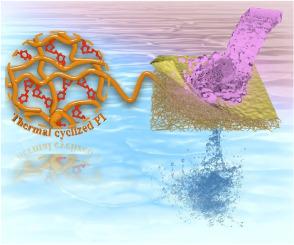Thermal crosslinking and cyclodehydration assisted fabrication of chemically robust thin-film composite (TFC) membranes for ultrafast polar solvents filtration
Abstract
Organic solvent nanofiltration (OSN) offers an energy-efficient alternative to conventional thermal distillation processes for organic solvent separations. However, the fabrication of polymeric OSN membranes with adequate chemical stability in strong polar aprotic solvents remains a remarkable challenge. In this work, chemically robust polyamide thin-film composite (TFC) OSN membranes were fabricated by utilizing an innovative chemical modification of polyimide (PI) nanofiber substrate via one-step crosslinking and thermal cyclodehydration of terephthalic hydrazide (TPDH). The crosslinking and cyclodehydration reaction mechanisms were thoroughly elucidated and the effects of TPDH loading and thermal treatment conditions on solvent resistance and pore structure of the resulting TPDH/PI nanofiber substrates as well as the formation of the polyamide selective layer were systematically studied. The resulting TFC membranes show excellent stability in polar aprotic solvents (i.e., DMF, DMAC, and NMP), and a high DMF permeance of 9.4 L m−2 h−1 bar−1 was achieved with a 99.8% rejection to Rose Bengal at 2.0 bar. The outstanding long-term performance stability revealed the robust structure of the developed TFC OSN membranes. This work demonstrates a facile strategy to address the chemical stability limitations of TFC OSN membranes through a multifaceted yet generalizable approach of chemical crosslinking and thermal cyclodehydration. We believe this strategy can be broadly applied to different substrates, enabling TFC membranes to address a wide variety of unmet OSN needs.


 求助内容:
求助内容: 应助结果提醒方式:
应助结果提醒方式:


